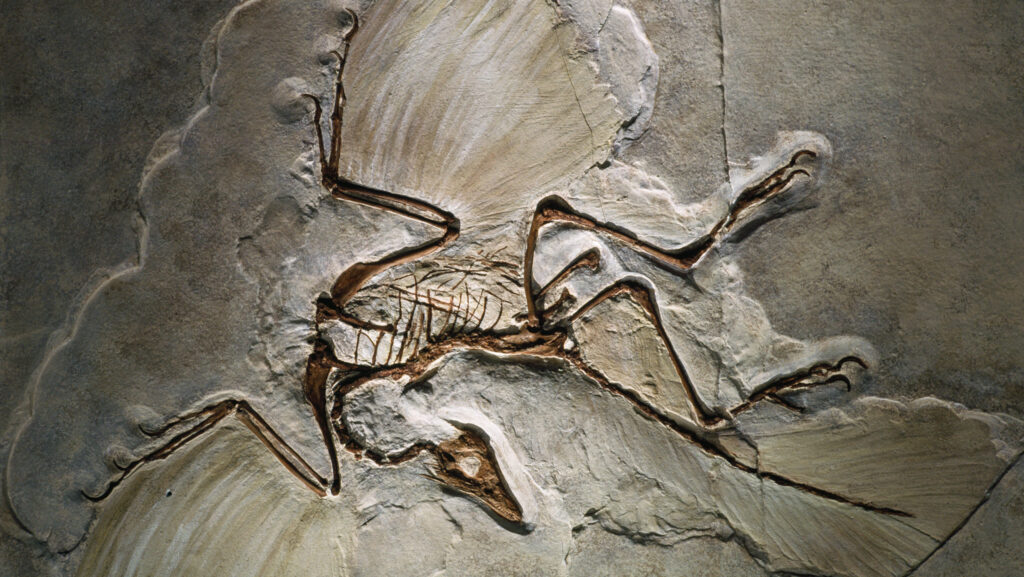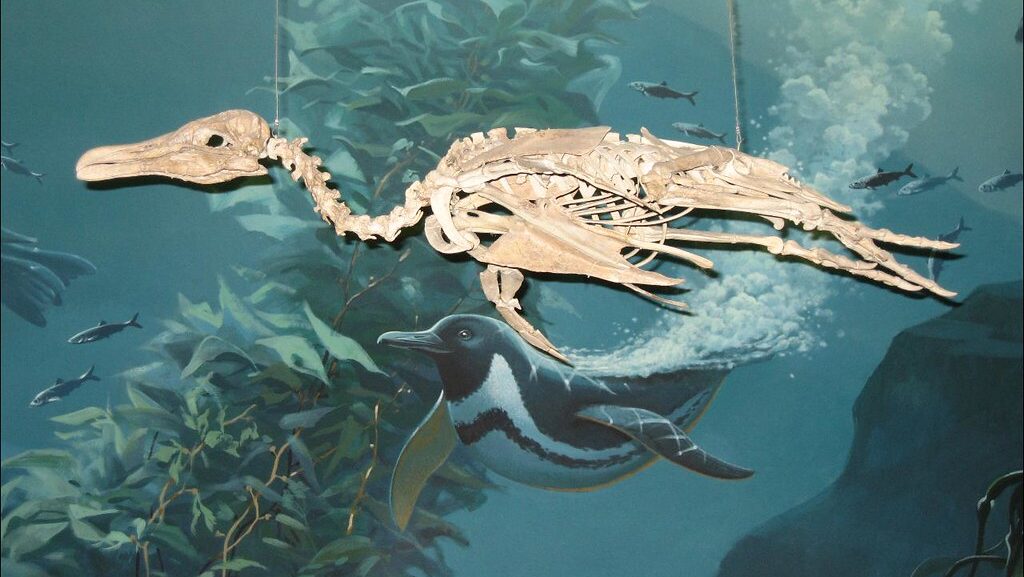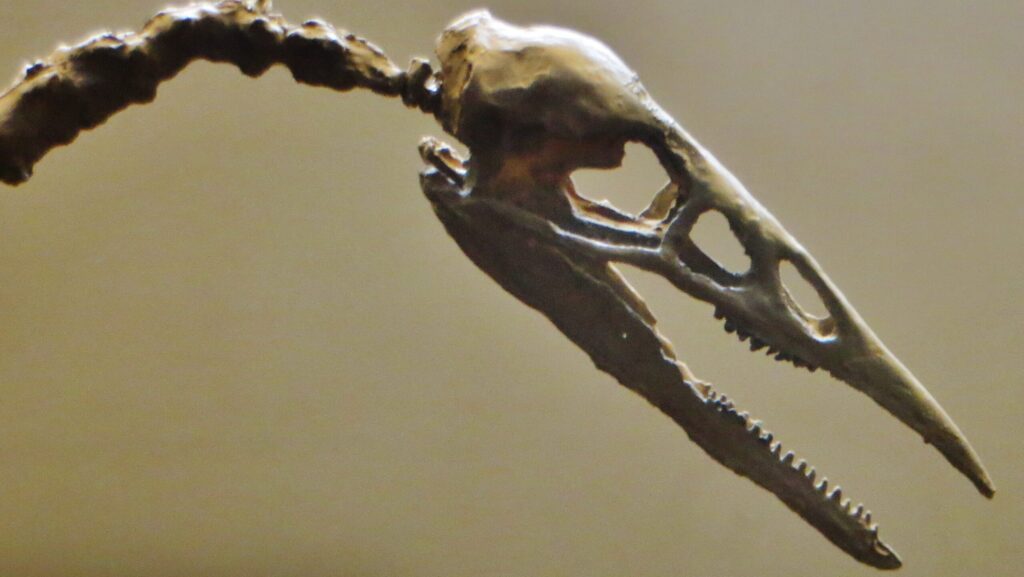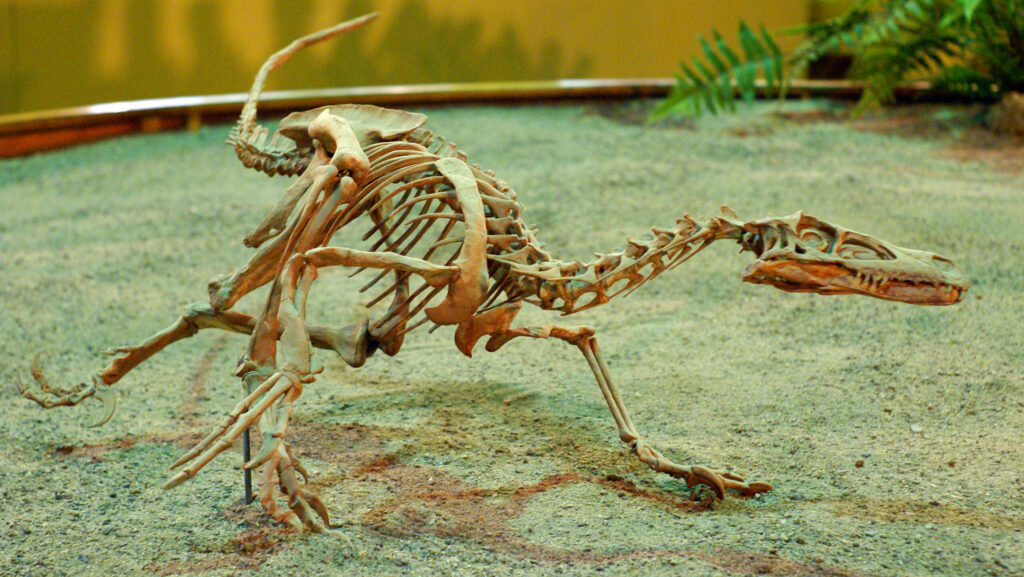The prehistoric world was filled with fascinating creatures that have long since vanished, leaving only fossilized clues about their existence. Among these ancient beings, prehistoric birds hold a special place in evolutionary history. These feathered ancestors navigated the skies (or sometimes couldn’t) long before modern birds took flight, and their stories reveal surprising secrets about avian evolution and Earth’s distant past. From massive flightless predators to bizarre toothed swimmers, these seven prehistoric birds challenge our understanding of what it means to be a bird and hint at evolutionary pathways that remain mysterious even to modern paleontologists. Let’s uncover what these ancient avians might be “hiding” from us – the remarkable adaptations, surprising relationships, and evolutionary mysteries that continue to fascinate scientists today.
Archaeopteryx: The Missing Link That Wasn’t Quite What We Thought

Discovered in 1861 in Germany, Archaeopteryx has long been celebrated as the perfect transitional fossil between dinosaurs and birds, but this 150-million-year-old creature is hiding more complexity than initially believed. Scientists once positioned it as the direct ancestor of modern birds, but newer research suggests it was more likely a side branch in avian evolution rather than our direct feathered forefather. Archaeopteryx possessed an intriguing mix of reptilian and avian features—teeth, a bony tail, and clawed fingers alongside unmistakable feather impressions—creating a mosaic creature that challenges simple evolutionary narratives. Perhaps most surprising is what recent UV light examination of fossils revealed: Archaeopteryx’s flight capabilities were likely quite limited, suggesting it may have been more of a glider than an active flyer, hiding a lifestyle different from what many imagined for this iconic prehistoric bird.
Hesperornis: The Toothed Diving Bird With a Surprising Propulsion System

Hesperornis was a flightless diving bird from the Late Cretaceous period that conceals one of evolution’s most fascinating experiments in aquatic adaptation. Unlike modern diving birds, this 6-foot-long prehistoric swimmer retained sharp, reptilian teeth in its beak—a reminder of birds’ dinosaurian heritage that modern species have completely abandoned. What Hesperornis hides most cleverly is its unique locomotion method: while modern diving birds typically use their feet as paddles positioned at the body’s center, Hesperornis had powerful legs located far back on its body, making it virtually unable to walk on land but extraordinarily efficient in water. Analysis of Hesperornis fossils reveals another secret: specialized bones that were particularly dense, allowing these birds to dive deeply with less effort by countering buoyancy—an adaptation parallel to what we see in modern penguins, despite no direct evolutionary relationship. This convergent evolution showcases nature’s tendency to reinvent successful adaptations across unrelated lineages, with Hesperornis hiding evidence of evolutionary pathways that would eventually be abandoned.
Patagopteryx: The Bird That Gave Up Flight Earlier Than We Knew

Patagopteryx, a turkey-sized bird from Cretaceous Argentina about 80 million years ago, hides evidence that challenges our understanding of how and when birds abandoned flight. Unlike later flightless birds like ostriches that clearly evolved from flying ancestors, Patagopteryx appears to have given up flight remarkably early in avian evolutionary history, suggesting multiple independent instances of flight loss throughout bird evolution. What’s particularly deceptive about this prehistoric bird is its seemingly primitive appearance despite being a relatively advanced avian—its wing bones show clear signs of reduction rather than underdevelopment, revealing that it descended from flying ancestors but adapted to a fully terrestrial lifestyle. Patagopteryx’s leg structure tells paleontologists that it was likely a quick, agile runner, hiding behavioral adaptations that compensated for its flightlessness in a world still dominated by dinosaurs. Perhaps most surprisingly, its brain case suggests it retained the enhanced vision typical of flying birds, hiding cognitive capabilities developed for aerial life that remained useful even after it became earthbound.
Iberomesornis: The Tiny Bird Hiding Modern Features in an Ancient Package

Iberomesornis, whose name means “Spanish intermediate bird,” conceals surprising anatomical features that were ahead of their evolutionary time. This sparrow-sized bird from Early Cretaceous Spain (about 125 million years ago) hides evidence of how quickly certain modern avian features evolved, possessing a fully developed pygostyle (fused tail vertebrae that support tail feathers) while still retaining primitive characteristics like clawed fingers. What makes Iberomesornis particularly secretive is how it challenges traditional views of avian evolution—its skeleton shows a mosaic of features that appeared in seemingly “incorrect” order according to earlier evolutionary models, suggesting bird evolution followed multiple parallel paths rather than a single linear progression. The exquisitely preserved fossils reveal another hidden aspect: evidence of well-developed flight muscles, indicating this tiny prehistoric bird was likely a strong, agile flyer despite living in a time when bird flight was still in relatively early evolutionary stages. Iberomesornis essentially hides an evolutionary experiment that worked remarkably well, incorporating features that would become standard in modern birds millions of years before they fully dominated the skies.
Ichthyornis: The Seabird With a Dinosaur’s Smile

Ichthyornis, a tern-like seabird from the Late Cretaceous period, conceals one of the most dramatic examples of the transition between dinosaurian and avian features in its skull structure. While appearing quite bird-like in overall body plan, this prehistoric flyer hid a mouth full of sharp teeth set in jaws that still functioned more like a dinosaur’s than a modern bird’s beak—essentially wearing a dinosaur’s smile beneath its otherwise modern appearance. What recent CT scanning of Ichthyornis skulls has revealed is perhaps its best-kept secret: its brain was already remarkably bird-like, with enlarged visual processing centers and reduced olfactory regions, despite its more primitive skeletal features. Ichthyornis is particularly deceptive in appearing thoroughly modern in its flight capabilities—with a keeled sternum and wing structure nearly indistinguishable from today’s birds—while simultaneously preserving ancient features that would eventually disappear from the avian lineage. This creature effectively hides the complex reality of mosaic evolution, where different body systems modernize at different rates, making it impossible to draw a clean line between “dinosaur” and “bird.”
Mononykus: The One-Clawed Wonder That Defies Classification

Mononykus, whose name means “one claw,” hides one of paleontology’s most persistent identity crises, with scientists debating whether this unusual Late Cretaceous creature should be classified as a bird or a non-avian dinosaur. This meter-long animal from Mongolia concealed its true nature behind a bizarre body plan—tiny forelimbs with a single enlarged claw, long running legs, and a skull with bird-like features but lacking a true beak. What Mononykus hides most effectively is its lifestyle, with its unusual anatomy suggesting specialized adaptations that have no perfect modern analog; the leading theory proposes it used its single claw to break into insect nests or tear apart rotting logs, filling an ecological niche no modern bird occupies. Recent analysis of its inner ear structure reveals another secret: Mononykus had balance and hearing adaptations similar to modern birds, suggesting it shared sensory capabilities with its avian relatives despite its unusual appearance. This creature essentially obscures the very definition of “bird,” highlighting how messy evolutionary transitions can be and challenging our tendency to place extinct creatures into neat categorical boxes.
Gastornis: The Giant “Terror Bird” That Wasn’t So Terrible After All

Gastornis (formerly known as Diatryma) concealed its true nature behind a fearsome appearance that led generations of paleontologists to misinterpret its lifestyle and diet. Standing over six feet tall with a massive head and powerful beak, this Eocene bird was long portrayed as a predatory “terror bird” chasing down mammals in the forests of early Cenozoic Europe and North America. What isotope analysis of its fossilized bones has recently revealed, however, is that Gastornis was hiding a surprisingly gentle diet—it was likely herbivorous, using its powerful beak to crack tough nuts, seeds, and hard plant material rather than tear flesh. The structure of its feet provides another clue to its hidden lifestyle: unlike true carnivorous birds, Gastornis lacked the sharp talons necessary for capturing prey, instead having blunt toes better suited for walking and standing. Perhaps most deceptively, Gastornis occupied ecological niches left vacant after the dinosaur extinction, hiding evidence of how birds adapted to fill roles previously unavailable to them when large dinosaurs dominated terrestrial ecosystems. This giant bird essentially hid in plain sight, its intimidating appearance masking a lifestyle more similar to a massive ground-dwelling parrot than the fearsome predator depicted in outdated reconstructions.
The Evolutionary Experiments Hidden in Prehistoric Bird Wings

Prehistoric birds hide numerous evolutionary experiments in flight that never made it to modern times, revealing alternative pathways that avian evolution explored before settling on current designs. Unlike the relatively standardized wing structures seen in modern birds, ancient avians experimented with various wing shapes, feather arrangements, and even the fundamental bone structure underlying their flight apparatus. Confuciusornis from Early Cretaceous China, for instance, hid a surprising adaptation in plain sight: long, ribbon-like tail feathers that likely served display purposes rather than aerodynamic functions, suggesting sexual selection played a role in bird evolution even before flight was fully optimized. Other prehistoric birds concealed strange wing claws that modern species have entirely lost, with some species retaining three fully functional clawed digits while simultaneously developing advanced flight feathers. Perhaps most hidden from casual observation is the evidence that prehistoric birds had a much wider range of flight styles and capabilities than modern birds, with some species showing adaptations for soaring that don’t quite match any living bird’s wing structure. These ancient wings essentially hide an evolutionary playground where nature tested configurations that ultimately proved less successful than the standardized design that most modern birds have converged upon.
The Secret Lives of Prehistoric Bird Hatchlings

The developmental patterns of prehistoric bird hatchlings hide crucial evidence about the evolution of avian life histories that fossilized adults cannot reveal. Recent discoveries of embryonic and newly hatched prehistoric birds, particularly from Chinese deposits, show that many early birds hatched in a much more developed state than modern birds, with more fully ossified skeletons and possibly greater mobility immediately after hatching. What these ancient hatchlings hide from casual observation is evidence of a fundamental shift in avian development strategies—from the precocial (relatively mature and mobile at hatching) pattern seen in many prehistoric species to the altricial (helpless and requiring extensive parental care) pattern common in many modern songbirds. Microscopic analysis of bone tissues in some fossilized hatchlings reveals another secret: growth rings similar to those in reptiles, suggesting some prehistoric birds grew more slowly than their modern counterparts, hiding evidence of metabolic differences that may have influenced their ability to survive seasonal changes. These ancient nestlings essentially conceal the evolutionary experimentation with different developmental strategies before birds settled on the diverse patterns of growth and development we see in modern species.
The Hidden Diversity of Prehistoric Bird Vocalizations

While fossilized bones cannot directly preserve sounds, prehistoric birds hide surprising anatomical clues about their vocal abilities that paint a complex picture of ancient avian communication. The syrinx—the specialized vocal organ of birds—is rarely preserved in fossils, but its absence in some very early birds suggests they lacked the diverse vocal repertoire of modern species, possibly relying more on visual displays or simpler calls. What some prehistoric birds hide in their skull structure, particularly in brain regions associated with sound processing, is evidence that auditory capabilities evolved earlier than complex vocalization—these birds could hear well before they could sing elaborately. Fossilized throat bones in some specimens reveal another secret: some prehistoric birds likely had vocal capabilities somewhere between reptilian hisses or grunts and the complex songs of modern birds, representing transitional stages in the evolution of bird communication. The ear structures of certain prehistoric species suggest sensitivity to different frequency ranges than modern birds, hiding evidence that the acoustic world of ancient forests and shorelines may have sounded quite different, with prehistoric birds filling sonic niches that no longer exist in today’s avian communities.
The Climate Secrets Prehistoric Birds Are Keeping

Prehistoric birds hide valuable information about ancient climates and environments that complement other geological and paleontological data. The global distribution of certain temperature-sensitive prehistoric bird groups reveals surprising information about past climate conditions—for instance, the presence of primitive penguins in what is now Australia suggests dramatically different ocean temperatures in the Southern Hemisphere during the Eocene epoch. What the anatomical adaptations of prehistoric birds often conceal is evidence of environmental pressures different from those faced by modern species—some showing adaptations to higher oxygen levels, different seasonal patterns, or forest structures that no longer exist. The diet-related adaptations of prehistoric birds, determined through rare fossilized stomach contents or isotope analysis, hide evidence of food webs and ecological relationships that have been completely restructured over millions of years. Perhaps most secretively, the extinction patterns of prehistoric birds during various climate change events throughout Earth’s history hide potential warnings about which avian adaptations prove vulnerable during environmental shifts—information increasingly relevant as modern birds face anthropogenic climate change.
How DNA Is Unveiling Prehistoric Birds’ Biggest Secrets

While ancient DNA rarely survives in fossils millions of years old, new molecular techniques are helping unveil secrets that prehistoric birds have kept hidden for eons. Researchers can now analyze proteins from some exceptionally preserved fossils, including prehistoric bird remains, revealing molecular evidence of evolutionary relationships that skeletal features alone cannot show. What prehistoric birds hide in their biochemical signatures is evidence of how fundamental physiological processes evolved—protein analysis from some fossils suggests when certain uniquely avian biochemical pathways emerged, such as those related to feather development or eggshell formation. The molecular clocks calibrated by combining fossil evidence with DNA from modern birds reveal another secret: the timing of major evolutionary radiations, showing that many bird groups were quietly diversifying earlier than the fossil record alone would suggest. Perhaps most revolutionary is how ancient DNA analysis has revealed cases of convergent evolution where prehistoric birds that looked similar were actually unrelated, hiding evidence that particular body shapes and adaptations have evolved multiple times independently throughout avian evolutionary history.
Conclusion: What These Ancient Avians Reveal About Evolution’s Complexity

The seven prehistoric birds we’ve explored reveal that avian evolution was far from a simple, linear progression from dinosaur to modern bird. Rather, it was a complex branching process with numerous evolutionary experiments, false starts, and parallel developments occurring simultaneously across different lineages. These ancient birds hide evidence that evolution often works like an inventor’s workshop—testing configurations, keeping what works, abandoning what doesn’t, and occasionally revisiting old designs in new contexts. The mosaic nature of these prehistoric birds, with modern features appearing alongside primitive ones in unexpected combinations, challenges simplistic views of evolution and reminds us that natural selection works on entire organisms within specific ecological contexts, not on isolated traits. What these seven prehistoric birds ultimately hide from casual observation is the remarkable story of how feathered dinosaurs gradually transformed into the diverse birds that surround us today—not through any predetermined plan, but through countless generations of adaptation to changing environments, predator-prey relationships, and competitive pressures. In studying these ancient avians, we gain not just knowledge about birds themselves, but deeper insight into the fundamental processes that shape all life on Earth.
